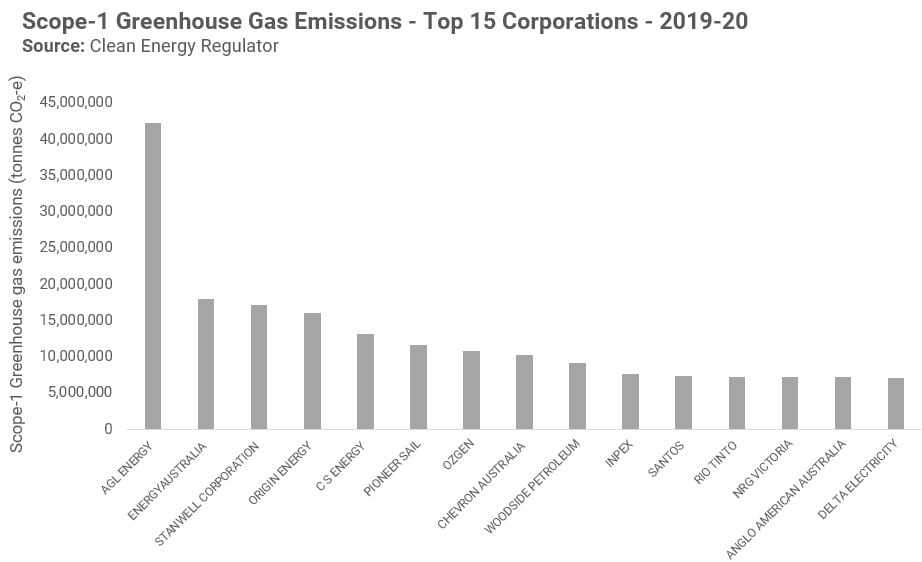Australia’s big energy companies have again ranked as the country’s largest emitters, with the operators of Australia’s coal fired generators dominating the latest list of the dirtiest companies.
The Clean Energy Regulator published the latest batch of emissions and energy data collected under the National Greenhouse and Energy Reporting scheme (NGERs), outlining the emissions footprints of more than 400 of Australia’s largest emitters.
AGL has again ranked as Australia’s largest corporate greenhouse gas emitter, reporting scope-1 emissions of 42.2 million tonnes in the 2019-20 financial year, more than double the next highest emitter.
Australia’s ‘big three’ electricity companies dominated the top of the list, with EnergyAustralia, the second largest emitter, reporting emissions of 17.9 million tonnes for the year, with Origin Energy ranking fourth at 16 million tonnes.
The Queensland government owned generators Stanwell Corporation and CS Energy ranked as the third and fifth largest emitters respectively, responsible for a combined 30.3 million tonnes of emissions.
Oil and gas producers also ranked highly, with Chevron Australia reporting emissions of 10.2 million tonnes, Woodside Petroleum reported 9.2 million tonnes of emissions and Santos produced 7.3 million tonnes during the 2019/20 financial year.
Energy intensive resources companies, including Rio Tinto, Anglo American Australia, South32, Glencore, Alcoa and BlueScope all ranked amongst the top 20 largest emitters.
AGL topped the list, recording significantly higher emissions than any other Australian corporation, by virtue of owning Australia’s two largest emitting power stations, the Loy Yang A brown coal power station (16.7 million tonnes) and Bayswater black coal Power Station (14.0 million tonnes). It also owns Liddell.
AGL Energy was responsible for around 8 per cent of Australia’s total greenhouse gas emissions.
Greenpeace Australia singled out AGL Energy due to its ranking as, by far, Australia’s largest emitter saying the energy giant needed to reconsider the role of coal in its generation portfolio.
“Australians are on the frontline of the climate crisis which is primarily driven by the mining and burning of coal, and now AGL has emerged as the biggest climate polluter in the country,” Greenpeace Australia Pacific campaigner Glenn Walker said.
“Australians who get their energy from AGL have done so in good faith, trusting that AGL is living up to the marketing reputation it has created, but this data reveals that behind the sleek, modern veneer AGL is still using dirty and dated methods to provide Australians with electricity.”
“Two out of three of AGL’s coal-burning power stations are set to close well beyond what scientists are calling for in order to prevent further catastrophic climate change. In order to protect Australians from the worsening impacts of climate change, all of AGL’s coal-burning power stations need to close by 2030 at the latest and be replaced by clean and safe renewable energy,” Walker added.
Responding to the report, a spokesperson for AGL Energy said the company recognised its responsibility to support investment in lower emissions energy sources.
“AGL understands its responsibility as Australia’s largest energy generator and retailer to drive the transition to a cleaner energy future, while maintaining reliable and affordable energy for our customers,” an AGL Energy spokesperson told RenewEconomy.
“Last year, we released our Climate Statement comprising five key commitments and our target of net zero emissions by 2050. Our statement provides an important framework that will guide our future actions and growth, recognising that customer demand, community expectations and technological advancements are the core drivers of Australia’s energy transition.”
“AGL has published dates for the closure of our coal-fired power stations. We remain committed to these and the transition plans while progressing investments for projects that transition our portfolio,” the spokesperson added.
The Clean Energy Regulator noted that there had been some reductions in emissions across various sectors in the 2019-20 year, which mostly covers a period leading up to the impacts of the Covid-19 pandemic.
Emissions from the electricity sector fell 7.5 million tonnes compared to the year prior as falling demand and increased generation from wind and solar projects push more emissions intensive plants out of the market. Emissions from the oil and gas sector also decreased by 3.4 million tonnes, due to reduced venting and flaring of gas.
The latest quarterly update to Australia’s greenhouse gas emissions, covering the period to the end of September 2020, are due to be published by the end of February.












